Jim Shaw and the Rover P6
Brakes and Simulated Mountains
Design
During the design phase of the P6 my father was Project Engineer for P4 so he is unlikely to have had any direct influence on the design of P6, however given the nature of Rover engineering at that time and his responsibilities for brake systems on a current vehicle I am sure he must have been aware of what was being considered. There are are, after all, limited numbers of engineers working with brake component supplier in contact with the various car manufacturers so it is almost certain that he would have been asked for his advice.
In 1963 he became the company's first Brake Project Engineer and began to take on some formal responsibility for the P6. By July 1963 he must have noticed how dim the 'handbrake warning light' in the P6 was and then gone on to criticise the emphasise that the technical authors of the various Owner's Handbook had placed on its twin functions. What had started out as an alerting signal to drivers of automatic cars now had the safety function of warning of low brake fluid level. As originally designed it seems that P6 was in danger of losing a safety function built into P4/P5, which is strange given that P6 must have been one of the first cars in the UK to be marketed for its safety features. (All organisations have the ability to forget the lessons that they have learned, probably because the learning is within individuals and they inevitably 'move on').
Alpine cooling and brake fluid vaporisation
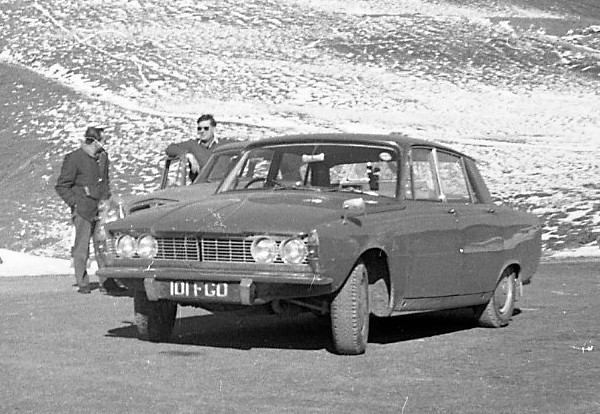
In early 1963 pre-production P6 101 FGO, chassis no. 40000001A, undertook cooling trials in the Alps. Incidentally it was found that there was a potential brake problem. Ken Robbins, my father's assistant, recalls that a tourist-type descent at a modest 28 mph, braking through the 48 hairpin bends of the Stelvio pass, and then parking up for 20 minutes could result in the brake pedal sinking to the floor.
To investigate this further my father went back to the Alps with Ken Robbins and Mike Lewis from Rover and Brian Spicer from Dunlop with 101 FGO, and Dunlop's Jaguar 676 HNX in October 1963. The primary purpose was to investigate if brake fluid vapourisation was occuring and the conditions that produced it. It wasn't so much a problem during actual braking but rather the period of parking, that became known as the 'soak' period, during which heat from the brake disc, no longer being cooled by moving air, transferred to the brake caliper and thence to the brake fluid.
(The author James Taylor 1 has written that 101 FGO was originally painted Willow Green and probably as a result the Lledo Vanguards model VA27003 reproduced that. However, as a brake systems development vehicle it was finished in City Grey with biscuit trim, lacked a radiator badge and carried the 'Talago' script badges, and was registered as such. This was certainly its state during the Alpine trials.)
Alpine Simulation
The experience of the conditions on the Stelvio fed into my father's other work on SMMT brake committees. In December 1964 he wrote that the proposed SMMT "Arduous Road Duty Brake Test for Passenger Cars and Dual Purpose Vehicles" was of dubious value. He wrote:
We have investigated many Alpine test schedules used in the Industry and found that none of them would correlate with results obtained in the Alps - certainly as far as disc brakes are concerned.
In general - in order to get the work input - the tests are conducted at such excessively high speeds that the cooling conditions are upset. These tests can produce disc temperatures much higher than occur in Alpine conditions whilst producing brake fluid temperatures much lower than occur and although they may given a useful basis for assessing lining fade they do not give a severe enough assessment from the fluid vaporisation point of view.
In other words vehicle brake engineers had traditionally been concerned with the problem of 'brake fade', the reduction of the coefficient of friction of brake lining materials as they got hot, and had therefore concentrated on carrying out high-speed, steep-descent, (high energy) stops. Fluid vaporisation was a new problem, in part created because the disc brake was less prone to brake fade as the exposed, and possibly force-ventilated, brake pads cooled better than enclosed brake shoes.
My father then went on to describe a method that he had devised for reproducing 'Stelvio' conditions on the test track:
We tried to reproduce the work input of an Alpine descent by using the test vehicle's own engine, but have found that this generates engine and transmission temperatures which can upset the front to rear distributions at the brakes and can result in rear end vaporisation when front end trouble ought to have been achieved.
We have, however, found that towing the test vehicle using a draw bar pull indicating towbar and instructing the tug driver to attempt to maintain a stated pull, can give maxima and rates of rise of disc and fluid temperatures closely in agreement with the data collected on Alpine descents.
Coventry Technical College (now Coventry College) held a special lecture course on motor vehicle design between January and March 1965. My father gave a lecture in that series on 1 February 1965 entitled "Brakes - Design and Development Testing". During that lecture he described the simulation method as:
"The tow bar is 16 ft. long to minimise airflow disturbance round the test car, and is arranged with a pull indicator displayed in the tug vehicle. The tug driver is instructed to maintain the pull decided upon (340 lb. in this case) while the test car driver drives as if on the Alps. The speeds are 30 down to 15 mph with 5 checks per minute of about 5 ft/sec2. Three circuits of the inner lane of the MIRA high speed circuit give the right distance."
101 FGO - Our first Rover
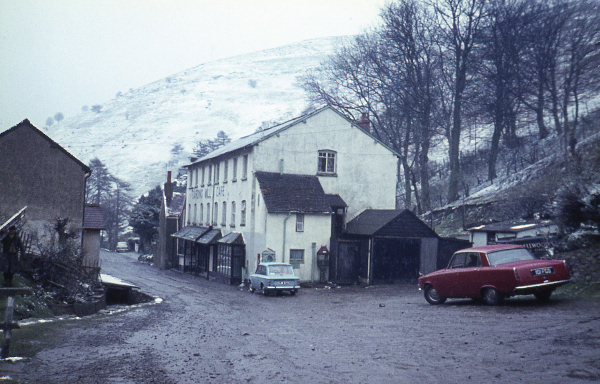
Towards the end of 1964 it must have been thought that 101 FGO was no longer representative enough of the production P6s and so on 20 November 1964 it was sold to my father for £60. There must have been a codicil of some sort, (might this have applied to all non-standard cars sold to Rover employees?), as a letter from the company's secretary required him to return the log book to the company once the change of ownership had been recorded. I imagine this meant that the car could not be disposed of without the company's permission, perhaps to protect undisclosed innovations that might have been incorporated in the build.
The car may have been considered for sale earlier as a 'snagging list' from 13 August 1964 noted that the car had the following problems:
- Clutch thrust howl.
- Clutch judder.
- Heater controls gritty in operation.
- Grills motif missing.
- Tatty boot trim.
- Front and rear bumper iron boots missing.
- Cracked "wood" finisher, drivers door side, and does not mask fixings either side.
- Boot lid dented and ex "Talago" holes visibly blanked.
- "Talago" on one wing - no "Rover" and "2000" motifs.
- Glove locker catches poor - lids fall down.
- Sawtooth wear on front tyres - geometry?
- Body exterior scratches
- Short B.C post finishers (S.S. and rubber).
- Cracked rear lamp lenses.
- O.S.R. door dent.
- Torn windscreen rubber - top edge.
101 FGO was kept by my father until 11 December 1973, during which time it gained red trim, was re-painted Copperleaf Red, the plain aluminium switch rail replaced with a black covered rail, fitted with a TC head, converted to negative earth, fitted with intermittent wipers and dim-dip head lighting. Some of this might have just been 'catch up' but frequent changes to brake calipers and pads suggested some ongoing development work too. During its 58,221 miles with Dad the windscreen wiper drive cable broke, the steering box was replaced and the speedo cable broke, the later a month before the car was replaced. (By that time the company had introduced what was called the Management Car Plan (MCP), a lease scheme, partly to discourage senior personnel from driving competitor's vehicles into the company's plants! So the replacement was Rover 2200TC PXC 216M).
East African Trial

1965 saw the Rover 2000 East African Test. Nineteen participants, thirteen from Rover and the rest representing suppliers Lucas, Dunlop, Pressed Steel, Hertfordshire Rubber, Pirelli and Woodhead-Monroe attended from 6 September through to 17 October 1965. At any one time the team ranged in size from four to six members. My father was there from 1 October 1965 to 11 October 1965. He was issued with a 'to whom it may concern' letter to drive and sign import/export documentaion in respect of the following cars:
- Car Registration: EXC 184C
Chassis No: 40008714B
Engine No: 40022112E
- Car Registration: EXC 193C
Chassis No: 40016352B
Engine No: 41000002A - Car Registration: EXC 194C
Chassis No: 40304546B
Engine No: 40022057E - Car Registration: DXC 6B
Chassis No: 40000518
Engine No: 40018193 - Car Registration: DXC 8B
Chassis No: 40000800
Engine No: 40018023 - Car Registration: DXC 9B
Chassis No: 40000805
Engine No: 40018162
DXC 6B, DXC 8B and DXC 9B were the original Rover 2000 rally cars registered as 4 KUE, 1 KUE and 3 KUE. These numbers being retained for use on new rally cars. It is most likely that these cars retained the original red and white rally colour scheme. EXC 194C might have had left-hand drive, all the others being UK right-hand drive models, as appropriate for Kenya. During this visit my father bought a tankard carved out of stone and a camera. Unfortunately the only photograph of a car that he took was captured on the film leader so wasn't processed properly.
Before going out to Africa he was informed that Jamba means 'Hello', Kwa Heri means 'Goodbye' and Assanya Sana means 'thank you very much' in Swahili. He was also provided with 14 tablets of Nivaquine, an anti-Malaria tablet. (Fifty years before my grandfather had also set off for East Africa, but without such protection, eventually needing to be re-patriated after catching Malaria. He met 'Father Neptune' on the deck of a troopship; my father received a 'crossing the equator' certificate sitting in a BOAC VC10 airliner!)
Brake Servo Failures
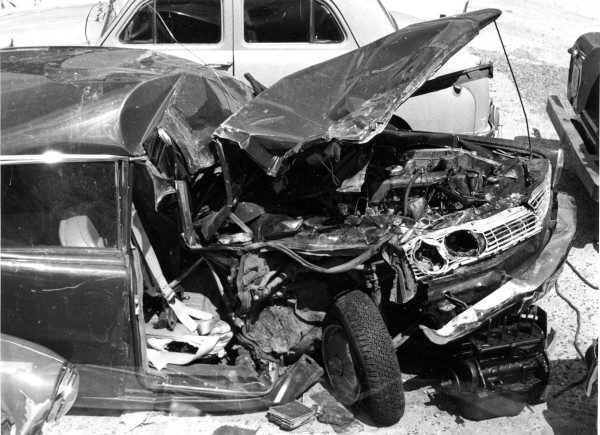
As a result of a couple of fatal collisions in 1966 and 1967 my father acted as an expert witness during the subsequent litigation process. (He proposed that the company create a full-time post of Litigation Engineer which, although initially favourably received, never happened). One accident involved a Rover 2000 colliding with a tree and the other a Rover 2000TC hitting a Royal Mail parcel lorry. Both cars were fitted with Lockheed Type 7 brake servos which the police accident investigators decided had failed, causing brake failure and resulting in collisions.
Lockheed carried out extensive testing and concluded that the servo failure could be induced with master cylinder line pressures of between 3,200 and 7,100 lbf./in2, typically at 4,200 lbf./in2. Swedish law (at the time the most demanding) required the equivalent of 1,600 lbf./in2 while a '1g stop' for a Rover 2000 takes 363 lbf./in2, i.e. the safety factor is about 10:1.
My father calculated that the force needed to decelerate the driver's leg, should the car impact with a solid barrier, was of the order of 693 lbf., equivalent to 5,050 lbf./in2 from the master cylinder. Thus it was the collision that caused the brake failure. He went on to produce a guide for accident investigators.
In the event the Rover Co. came to a settlement with the claimant, which seems to be the usual outcome as 'poor widow versus Big Company' probably costs more in bad publicity than the settlement 'out of court'. I suspect that the role of Litigation Engineer would have been a thankless task anyway, public relations always being the winner.
More Trials
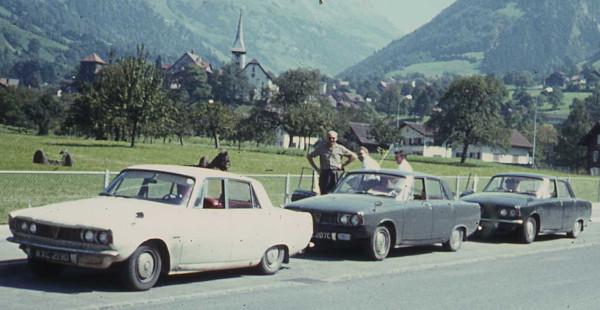
Trips to the Alps seemed almost to become an annual event, here KXC 219D, FXC 207C and KXC 218D take a break. KXC 219D was a lhd model and I believe FXC 207C was a Girling-operated development car. That was probably in September 1966.
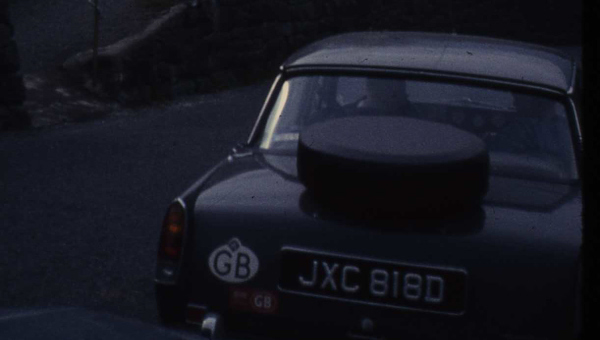
My father also made the trip with JXC 818D, a lhd variant of the first batch of P6B development cars, along with an unknown P5. The limited documentation that I have suggests it was in August 1969.
(I have read a claim2 that JXC 818D was used for cold climate trials in Canada. While that might be true I find it unlikely as photographs showing the car in snow have it bearing its UK registration, rather than a local plate, an Ontario requirement. What certainly would not be the case is that the car would have remained in Canada, a) because it wouldn't meet Canadian requirements and b) because despite what some enthusiasts and authors seem to think these cars were all capital assets and weren't discarded lightly). Norway was also used for cold climate trials. It is nearer and used to visits by UK registered cars, so to my mind, might have been the test location.
Incidentally its sister car JXC 822D was allocated to director William Martin-Hurst. There is some evidence that it might have been fitted with an experimental braking arrangement to determine what was desirable in terms of brake pedal 'feel', i.e. effort and travel. (Author James Taylor 3 says that the car was later sold to Martin-Hurst's son).
The best documented trip of all was an endurance run to Athens that my father carried out in September 1967 with P6B TXC 730F. His report is reproduced as 'Lode Lane to Lake Marathon'.
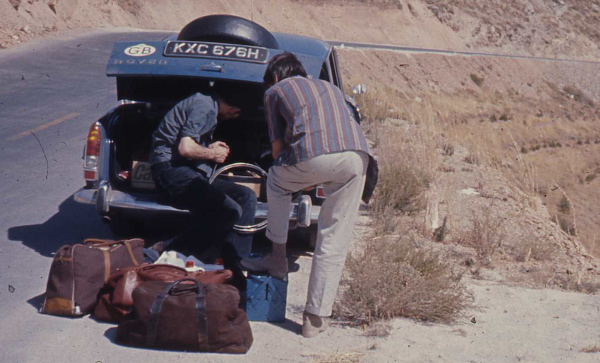
Another P6B, KXC 676H, prototype Rover 3500S, was subjected to a hot/high altitude run to Spain's Sierra Nevada, August - September 1970. (This car still survives and has been extensively restored).
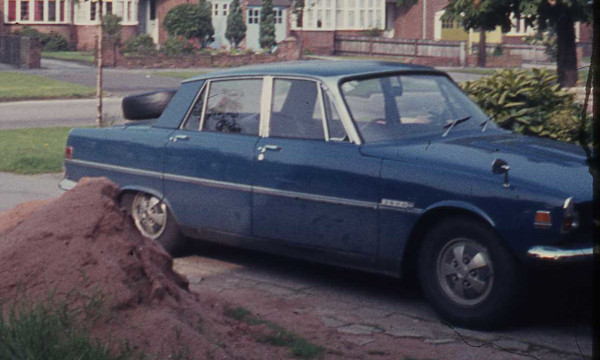
The early P6 European trials often used France as a point of entry to continental Europe. However P6B brought an end to that as French customs didn't believe that any car needed eight spare spark plugs, so Belgium or Holland were used instead.
There could well be other European P6 trials that my father carried out, (possibly to Rome or in Sweden) but I don't have any substantial evidence as my father kept only the briefest of diaries.
Unrealised Developments (1) - Full Power Hydraulic Brake
Early in 1964 Rover had asked Girling to make recommendations for the operation of brakes and levelling from a central power source for future versions of the P6 range. During a meeting held 6 April 1964 it was decided that high-pressure oil from an engine-driven pump would be the way forward. Girling was to investigate the use of a gear pump or the swash-plate pattern used in the Rover gas turbine car.
Clearly the Full Power Hydraulic Brake (FPHB), as used on the Citroën DS19 and trialled on P4 was again being considered for a production Rover.
My father wrote to Peter Wilks on 12 October 1967 on the subject of a policy for future braking systems, in part following industry proposals for 'split' braking systems, something that was becoming mandatory in some markets. (Conventionally all wheel brake pistons were operated in parallel from a common pressurised brake line. A failure of this line, by leakage or vapourisation of the brake fluid would result in total brake failure. Split schemes have more than one brake line. A simple split might operate the front brakes from one brake line and the rear brakes from another. Various schemes have been proposed, all the way up to full duplication).
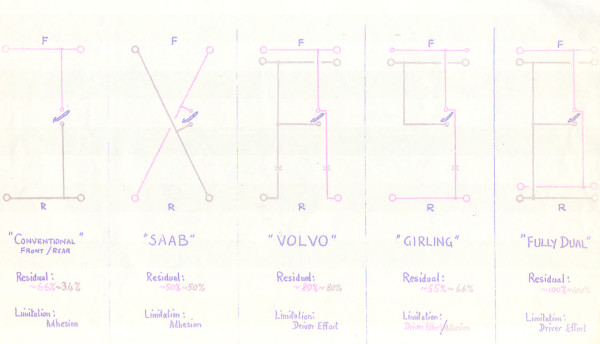
He was of the opinion that all split schemes can suffer common-mode failures, such as vapourisation. If severe braking caused vapourisation on one half of the split then it wasn't impossible that continued severe braking, (i.e. the 'Stelvio' scenario), would induce vapourisation on the other half, particularly as that now provides all of the braking effort. The solution would be to adopt FPHB. He wrote:
- 6. Full Power braking has been available on Citroën cars for 12 years and is now fitted to cars [priced] at £1339.
- 7. Lockheed now have a dual control-valve.
- 8. The P6.B Mk.2 is likely to have hydraulic pump-actuating capacity available with a return to an electric fuel pump (J. Swaine memo of 6th October, P6.B.13 U.S.A. Test, item 1.5). and this solution could be invoked on all Rover cars to overcome any difficulties on drive provision. A Citroën pump has been schemed into this position by Design Research.
[Continues with para. 9 then signed]
J. Shaw
Brake Project Engineer
(As an aside it is of note how developments on a production vehicle may be contingent on other, seemingly unrelated, factors. At first glance engine fuelling arangements have nothing to do with brake systems, as in this instance.)
In an undated response to Girling, Rover detail the performance required by a FPHB system in terms of pedal travel and operating pressure and discuss how the driver should be alerted to any system fault. (P6B AXC 297F, fitted with a 4.6:1 servo and William Martin-Hurst's P6B JXC 822D had been used to provide performance baselines, dating this paper to 1968-69).
A performance graph dated 4 February 1969 details the performance of a Lockheed FPHB system fitted to TXC 733F, the car having travelled 14,849 miles at the time.
Unrealised Developments (2) - Overdrive
From his first days with Rover my father seems to have had some involvment with the electrical control of gearboxes. As discussed in conjunction with P4 this might have been because he was one of the few development engineers with an interest with things electrical. Certainly he was often an addressee on memoranda to do with the topic of overdrive, whatever vehicle it was proposed for.
It is equally true that he took a keen interest in a wide range of topics related to Rover, from styling, brochures, and office aids, forms, calculators and the like. I have several sketches of overdrive schemes for P6, showing the maximum speed for a given gear with various transmision options.
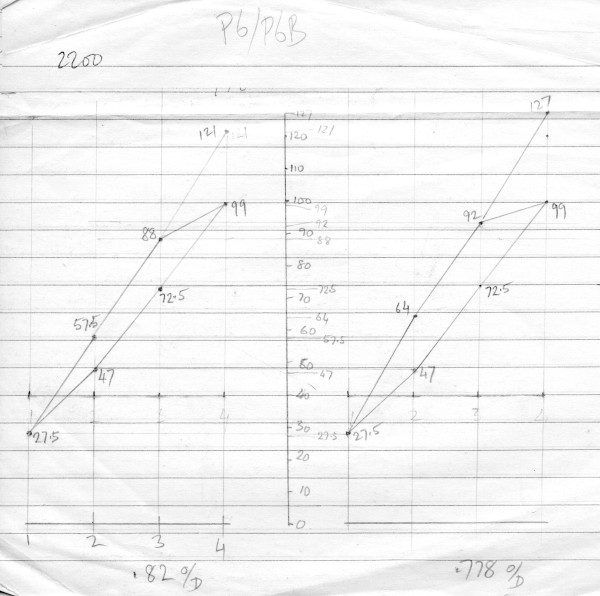
Given that the P6 to some extent was marketed as a 'sporty' car for the young executive but also as continuing the staid, sober Rover tradition it would make sense to offer the scheme that he developed in conjunction with William Martin-Hurst and trialled on the later's P5. This control system made use of the overdrive unit to provide an alternate gear sequence, i.e 1st, 2nd + overdrive, 3rd + overdrive, top and top + overdrive, rather than just 1st, 2nd, 3rd, top and top + overdrive, so-called 'Town and Touring', the mode selected by a switch on the dashboard.
Was this just speculation on my father's part, going no further than his own desk or was it seriously considered?
I understand that an overdrive scheme was trialled on P6 but what form it took I don't know. (The reason that the Martin-Hurst/Shaw overdrive scheme never went into a production car was probably one of cost as it needed another couple of relays and a switch, mass vehicle manufacturing being very cost-conscious.
Miscellaneous developments
Inevitably various unanticipated, issues will crop up during the manufacturing lifetime of a motor vehicle as weaknesses are exposed and suppliers make changes to their designs. That after all is what makes up a large part of vehicle development. The following are a few of those issues that my father had to deal with in connection with P6.
Hydraulic brake pipes: June 1966 an accident in Spain revealed fretting of a hydraulic brake pipe. The pipe in question was released for production before the first pre-production cars were built, so dated back to at least late 1962, pre-dating my father's responsibilities. Those raising the issue appeared to want an 'idiot proof' solution. However it was pointed out that the fitting of pipes is ultimately in the hands of production, the service department didn't like new variants of parts and increasing clearances, 'just in case' put pipes at risk from road damage. A general comment was made that clear channels rarely exist on the underside of vehicles and invariably they are closed off with sharp edges. Also other designers didn't always respect the routes used by brake pipes. (There had to be some reliance on the production operator acting intelligently).
Caliper aeration: August 1966 saw the first fitting of the Girling 10SIH brake caliper to a production Rover 2000. Within six months the seal profile had to be changed following complaints about fluid leakage and aeration. In August 1967 the seal material was changed from natural rubber to silicone butyl rubber and fitted to P6B pre-production prototype TXC 738F, engine development car, for trials. The problem appears to have been resolved by November 1968.
Disc corrosion: In November 1972 concerns were expressed over brake disc corrosion. An investigation concluded that there were methods that could prevent it but they were too expensive for use by Rover. However the increasing use of salt on roads, customer complaints and legislation might have altered that. In the meantime reasearch into cheaper methods had continued.
Metrication, Rationalisation and Technical Improvement
The status of the braking systems fitted to P6 and P6B was summarised in a paper issued by my father on 9 March 1971. In it he described pressure from brake supplier Girling to move towards 'metric'. Rover had resisted a change to a 'semi-metric' caliper as although it was interchangeable on production it used different pads. It was expected that fully metric calipers would be fitted from the end of 1972.
Clearly there had been some complaints about the braking systems on P6 and P6B, Which magazine criticising 'rear locking' on a P6TC for instance. My father's opinion was that wasn't justified as it was a designed-in feature to make better use of the brakes on low friction surfaces. Apart from a few customer complaints, 'notably from Paris' it hadn't been a problem.
More serious was the use of the wrong brake pads 'in the field', made possible because the rear calipers on P6/P6B were common but P6 used low μ pads and P6B high μ pads.
Getting changes made can't have been easy, he writes:
8) Although over many years we have been alive to the need for and the development of devices, components and systems which are capable of improving the braking performance of cars in particular aspects, we have actually incorporated few of these developments on production cars. Our competitors have apparently been much more advanced. Ratio valves are now widely used, whereas we do not fit these to any of our models. Revised split systems, departing from the F/R [front/rear] arrangement, are used on Volvo, SAAB. NSU, BMW and are likely to appear soon on others, whereas only Range Rover is so equipped.
Service Parts continuity and complex model variations which do not lend themselves to the rational inclusion of such devices as appear desirable, have legitimately contributed to our leaving these improvements on the shelf.
The programme of model changes including the introduction of P8, which was to incorporate initially, major technical advances in the braking system leading easily to the incorporation of a skid control system, must also have militated against any attempt to steal its thunder on the current models.
There was, however, before the announcement of P8 cancellation, comment from yourself [R.N. (Dick) Oxley] that we are being "left behind" with our current models.
It must have been very frustrating having to have held off making improvements to P6/P6B so that they could appear as 'new features' on P8, only to have that car be cancelled.
[See Jim Shaw and Rover P8 for proposals to salvage P8 systems for use on other cars]
He closes his situation summary thus:
9) The present specifications are tenable only on a limited basis, P6 failing the Swedish requirements for non-rear locking and P6 and P6B marginally failing the Swedish requirement on fade.
10) P6, having the lower μ rear lining dictated by its front caliper size and despite an over-rear-ended distribution by the standard of 9) above is becoming borderline.
The existing P6/P6B systems were illustrated by the following diagrams.
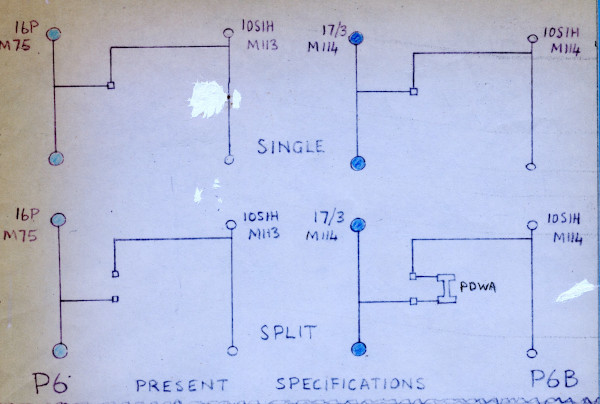
Three costed schemes were put forward for consideration by senior management, along with a proposal to extend brake pad wear monitoring to P6, (already fitted to P6B), for an extra £1.50 per car. There was also a proposal to use a two-level brake failure warning system based on the planned three-level scheme designed for P8, which would clearly differentiate between low brake fluid level and handbrake 'on'.
Finally my father proposed the use of a higher boiling point brake fluid, something that had been delayed as British Leyland, (by now Rover's owner), wanted, but failed, to standardise.
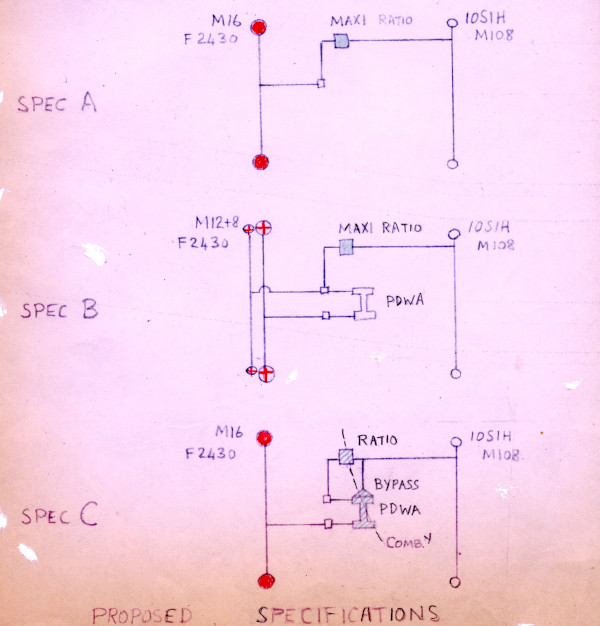
Director Peter Wilks sent a hand-written note to my father, dated 25 April 1971:
Thanks for progressing this and for your effective effort and initiative on these proposals. - PMW.
2. 'hermione149' (2010, March 26). 1966? I dont think so!! classicroverforum.net↩
3. Taylor, J. (2020). Rover P6. The Crowood Press Ltd. Ch. 6. ISBN 978-1785007217.↩